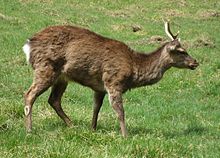Formosan sika deer
| Formosan sika deer | |
|---|---|
 |
|
| Scientific classification | |
| Kingdom: | Animalia |
| Phylum: | Chordata |
| Class: | Mammalia |
| Order: | Artiodactyla |
| Family: | Cervidae |
| Subfamily: | Cervinae |
| Genus: | Cervus |
| Species: | C. nippon |
| Subspecies: | C. n. taiouanus |
| Trinomial name | |
|
Cervus nippon taiouanus |
|
The Formosan sika deer, (Chinese: 台灣梅花鹿; pinyin: Táiwān méihuālù; Pe̍h-ōe-jī: Tâi-oân hoe-lo̍k), is a subspecies of sika deer endemic to the island of Taiwan. Formosan sika, like most of the terrestrial fauna and flora of Taiwan, arrived on the island during glacial periods when lower sea levels connected Taiwan to the Asian mainland.
Sika stand 90–120 cm at the shoulder. Males are larger and bear deciduous antlers. The summer coat is light brownish, with obvious white spots, while in winter their coat is darker and the spots fade.
The natural distribution of sika on Taiwan was in the woodlands from sea level up to about 300 m elevation. Sika, like many deer, prefer areas of mixed forest, scrub, and open land. Under natural conditions the low-lying alluvial plain that stretches from present-day Taipei along the west coast almost to the southern tip of the island were prime deer habitat and natural populations would have been quite dense.
Sika populations in Taiwan have been heavily influenced by human activity for the past four hundred years. Until the early 17th century the human population of Taiwan was low and comprised mostly Austronesian peoples who had been living on the island for thousands of years. During the 17th century immigration from the Chinese mainland increased dramatically in response to political instability in China and economic opportunities on Taiwan, which from 1624 until 1662 was controlled by the Dutch East India Company (VOC). The VOC, operating from the port of Tayouan (modern-day Anping, Tainan) in southwestern Taiwan, established a trading post whose main business was the export of sika skins to Europe. During the six decades of Dutch activity two to four million sika skins were exported to Europe. Exporting was reduced when the Dutch were forced out of Taiwan in 1662, but continued throughout the Qing period with a switch to Japan as the major export market.
The intensive hunting of sika during the Dutch era must have severely decreased the population of sika. Sika populations continued to decline over the next few centuries as the human population expanded—the natural habitat of sika in the lowland plains was steadily converted to farmland, and later urbanized, as the human population increased. Hunting also continued. As a result, wild sika populations decreased steadily, and in 1969 the last known wild sika was killed.
...
Wikipedia
